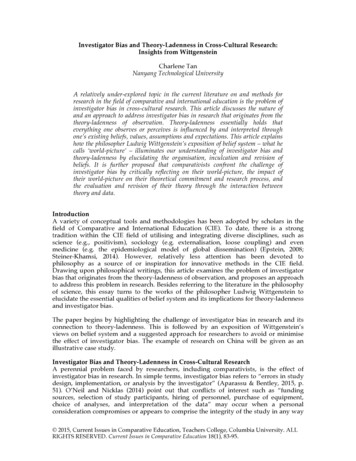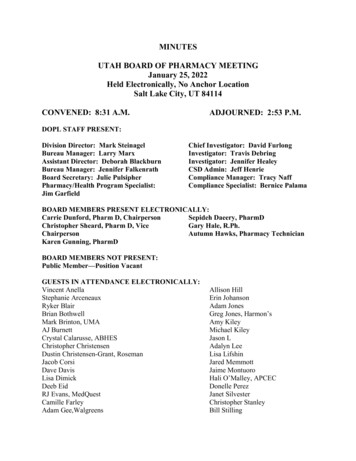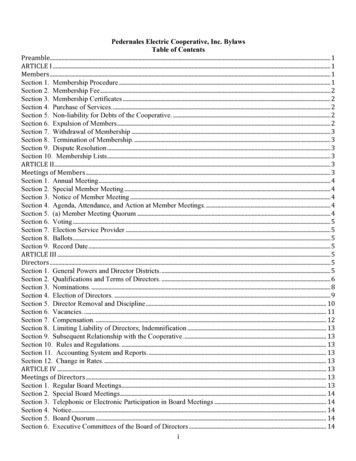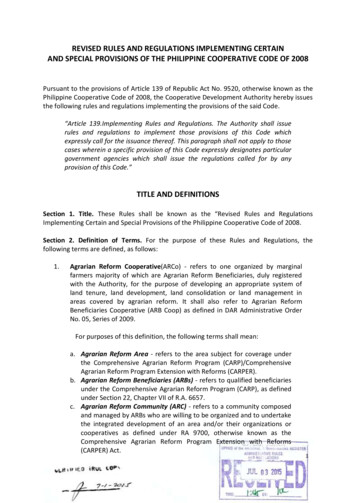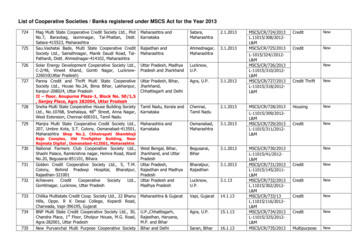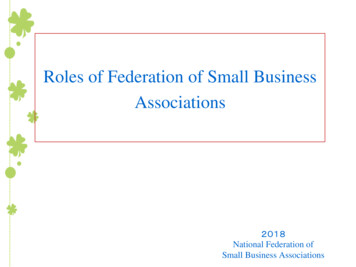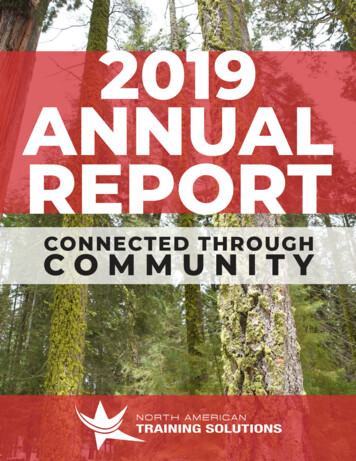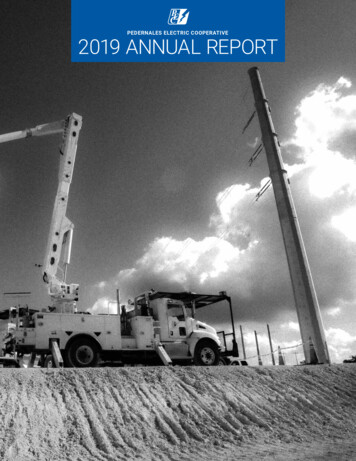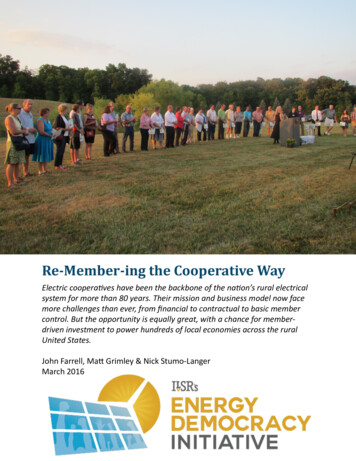
Transcription
COOPERATIVE STUDIESPROGRAMINVESTIGATORGUIDELINESFOR THE PLANNING AND CONDUCT OFVA COOPERATIVE STUDIESOFFICE OF RESEARCH AND DEVELOPMENTDEPARTMENT OF VETERANS AFFAIRS2018
Effective Date: March 20, 2018Approved by CSP Central Office
Table of ContentsI. INTRODUCTION . 1A. PURPOSE . 1B.COOPERATIVE STUDIES PROGRAM . 1C.CSP INVESTIGATORS . 3II. DEVELOPING A CSP STUDY . 3A. LETTER OF INTENT . 3B.LOI REVIEW . 6C.THE PLANNING COMMITTEE . 6D. PLANNING MEETINGS . 7E.CSSEC PROPOSAL . 8III. CSP SCIENTIFIC REVIEW . 8A. CSSEC WRITTEN REVIEWS. 8B.CSSEC REVIEW PROCESS . 9C.CSSEC RECOMMENDATIONS . 9IV. INITIATING A CSP STUDY . 10A. PARTICIPATING SITE SELECTION . 10Participating VAMCs. 11Hiring and Training of Study Personnel . 11B.CASE REPORT FORMS . 12C.STUDY OPERATIONS MANUAL AND TRAINING MATERIALS . 12D. INVESTIGATIONAL NEW DRUG APPLICATION AND INVESTIGATIONAL DEVICE EXEMPTION. 12E.ORGANIZATIONAL/TRAINING MEETING . 13F.RECRUITMENT PLANNING . 13V. CONDUCTING A CSP STUDY. 13A. CSP STUDY MANAGEMENT AND MONITORING . 14Study Group . 14Executive Committee . 14Data Monitoring Committee . 15CSP Human Rights Committee. 15Site Monitoring, Auditing and Resource Team . 16B.STUDY CHAIR RESPONSIBILITIES. 16C.MEETING/TRAVEL ARRANGEMENTS . 16D. PROTOCOL CHANGES, EXCEPTIONS, AND DEVIATIONS. 16E.CHANGE IN FUNDING SUPPORT . 17F.ETHICAL AND REGULATORY CONSIDERATIONS . 17G. STUDY DATA . 19
H. REPORTING OF ADVERSE EVENTS, SERIOUS ADVERSE EVENTS, AND UNANTICIPATED ADVERSE DEVICE EVENTS. 19I.BREAKING STUDY BLIND . 20J.DUAL ENROLLMENT . 20K.SUBPROTOCOLS / SUBSTUDIES . 20L.COMMUNICATIONS. 20M. SITE VISITS . 21N. REPLACING AN SI OR STUDY CHAIR . 21O. PUTTING A SITE ON PROBATION . 22P.EARLY TERMINATION OF A SITE . 22Q. CSP STUDY FILES . 23R.PERIODIC REPORTS . 23Local . 23CSP . 23VI. CONCLUDING A CSP STUDY. 24A. CLOSE OUT . 24Participants . 24Study Data / Results . 24Regulatory . 25B.FINAL STUDY MEETING. 25C.PUBLICATIONS . 25D. ADMINISTRATIVE REPERCUSSIONS . 26E.CUSTODIANSHIP OF DATA . 26F.RELEASE OF STUDY DATASETS . 27G. CONTINUING ANALYSIS ACTIVITIES. 28VII. CONCLUSION . 28APPENDIX A - GLOSSARY OF ABBREVIATIONS AND ACRONYMS . 29APPENDIX B - COOPERATIVE STUDIES PROGRAM AUTHORSHIP POLICY . 31
I.INTRODUCTIONA.PurposeCooperative Studies Program (CSP) research serves Veterans and the nation. Success is dependent upongood communication, cooperation, and a willingness to pursue a common goal. To achieve these outcomes,it is critical to perform specific responsibilities in a quality-based manner. These CSP Investigator Guidelinesprovide responsibilities, procedures and expectations for the five key phases of a CSP study. This documentis specifically intended for CSP Study Chairs and Site Investigators (SIs)—referred to herein collectively asCSP Investigators—to ensure consistent practices across all CSP studies within a quality managementframework. These guidelines also fall under the overall purview of CSP’s policy authority and supplementother quality documents maintained by CSP. CSP Center Directors may approve requests for exceptionsand/or seek CSP Central Office (CSPCO) concurrence when appropriate. Questions about any of thesematerials may be directed to a CSP Center and/or CSPCO.B.Cooperative Studies ProgramCSP, a division of the Veterans Health Administration (VHA) Office of Research and Development (ORD), isresponsible for the planning, conduct and funding support of multicenter clinical and epidemiologic researchstudies. The CSP mission is to advance the health and care of Veterans through cooperative researchstudies that produce innovative and effective solutions to Veteran and national health care challenges.CSP is a complete clinical research program that dates back to the 1940s during the earliest efforts indesigning and conducting multisite clinical trials in the United States. This national program works with VAclinician-investigators and facilities to perform VA research that addresses key questions for transformingpractice, and for developing innovations in how clinical trials and epidemiologic research are conducted, bothwithin VA and nationally.Organizationally, CSP reports to the Chief Research and Development Officer (CRADO) in ORD. CSPCO inWashington, DC, manages the infrastructure for and scientific portfolio of clinical trials, observational, andgenetic research through its network of clinical trials, epidemiologic, and recruitment centers throughout thecountry.CSP clinical trial expertise is comprised of professional experts located at five CSP Coordinating Centers(CSPCCs) at the VA medical centers (VAMCs) in Boston, MA; Hines, IL; Palo Alto, CA; Perry Point, MD; andWest Haven, CT. CSPCC staff include individuals with backgrounds in biostatistics and clinical researchmethods, project, administrative and budgetary management, and quality management and assurance.These centers help direct and support all phases of the research project, including: Proposal development Study implementation Central coordination of study conduct Data collection and managementCSP Guidelines 20181
Statistical analyses Study progress monitoring Compliance Study publication and disseminationUnique to CSP is its Clinical Research Pharmacy Coordinating Center (CRPCC), affiliated with the VAMC inAlbuquerque, NM. CRPCC was established to provide resources for all CSP studies, specifically onesinvolving drugs or devices. If needed, this center can manufacture, package, and distribute pharmaceuticalsto studies. Additionally, responsibilities include the following: Study planning and monitoring Liaising with the US Food and Drug Administration (FDA) and the pharmaceutical or deviceindustries Providing expertise regarding FDA regulations Reviewing and distributing reports of adverse events (AE) and serious adverse events (SAE)collected during the course of the study Centrally controlling and distributing study drugs and devicesCSP Site Monitoring, Auditing and Resource Team (SMART) resides at CRPCC and is responsible for thetraining and oversight of Good Clinical Practices (GCP) in CSP studies.CSP serves as sponsor for all of its studies. For interventional clinical trials, CSP follows responsibilitiesoutlined in ICH E6 Good Clinical Practice (GCP). Quality by Design principles are also applied to promoteefficiencies and mitigate risks and important errors throughout the lifecycle of the trial.There also are five CSP Epidemiology Centers (CSPECs) that conduct, coordinate, and support populationand genetics research. They emphasize observational methods of large cohorts and approaches that do notrequire a randomized approach to addressing clinical questions. These centers are located at VAMCs inBoston, MA; Durham, NC; Palo Alto, CA; Seattle, WA; and West Haven, CT.CSP Pharmacogenomics Analysis Laboratory (PAL) at the Little Rock VAMC in Arkansas is dedicated tohelping CSP studies that have genetic and/or pharmacogenomic data or biospecimens. With technologicaland analytical resources for such activities, the PAL provides another dimension for CSP to addressVeterans’ health care needs.CSP Network of Dedicated Enrollment Sites (NODES) is a core set of sites based at VAMCs to providerecruitment and other site-level insights for conducting clinical research. As part of the CSP infrastructure,NODES partner with CSP Centers and CSP Investigators to help overcome common barriers to conductingmultisite research. Collectively, NODES form a group that helps provide study-specific and program-wideCSP Guidelines 20182
solutions in study planning and subsequent execution by offering insights that have not traditionally beenincorporated in such activities. Within a given VAMC, a NODES team also can help navigate localprocedures and policies for conducting CSP research. NODES sites are located at VAMCs in Dallas, TX;Hines, IL; Houston, TX; Long Beach, CA; Minneapolis, MN; Palo Alto, CA; Portland, OR; Salt Lake City, UT;and San Diego, CA.CSP also partners with the Health Services Research & Development Service (HSR&D) Health EconomicsResource Center (HERC) at the VA Palo Alto Health Care System. HERC economists provide design andanalytical support in the conduct of CSP studies where cost effectiveness, quality of life, or other economicquestions are relevant.C.CSP InvestigatorsCSP Investigators and study personnel play a critical role in the success of CSP studies. Together with CSPCenters, they help with conceptualizing the research question and carrying out the study protocol. They alsodirectly interface with Veterans and other populations whom CSP research serves. While CSP centersprovide many of the key functions for a successful study, CSP Investigators also must share a commitmentto program values and processes. Key points are provided below to help them succeed in their efforts.Understanding these principles will help with achieving the standards expected in doing a CSP study.Serving as a CSP Investigator implies a commitment to Veterans first. CSP Investigators are expected toactively engage in the ethical conduct of research, oversight of clinical, scientific, and administrativeresponsibilities, and maintenance of the quality and integrity of the study in cooperation with study teammembers.Participating in a CSP study requires adherence to all applicable federal, VA, and CSP policies. CSP hasStandard Operating Procedures for most key activities in designing and conducting its studies. Training andoverviews are provided at various stages, and questions about responsibilities or roles on a study should bedirected to the CSP Center.Oversight and management responsibilities are delegated to CSP Centers and in accordance with VHADirective 1205. CSP Investigators are responsible to their assigned CSP Center(s) and, in turn, CSP Centersreport directly to CSPCO. CSP Centers will know how and when to engage others to seek additionalguidance and/or obtain approvals. CSP Center Directors may also approve requests for exceptions and/orseek CSPCO concurrence when appropriate.II.DEVELOPING A CSP STUDYA.Letter of IntentConducting a CSP study is demanding but rewarding. The successful planning, organization, conduct, andconclusion require the active engagement and cooperation of many individuals who must be willing and ableto devote time and energy to a study’s success. Participation in a CSP study is voluntary and doing soimplies a willingness to adhere to CSP policies in all respects. Prior to initiating a CSP study, one shouldconsider the requirements, demands, and team-oriented approach involved. Interested individuals maycontact CSPCO or other CSP Investigators for more details.CSP Guidelines 20183
The submission of a Letter of Intent (LOI) by an eligible VA clinician-investigator to CSPCO is the first step inCSP study-development process. The individual submitting the LOI is designated as the Principal Proponent.The LOI is a detailed proposal that describes the research question, need for a cooperative study, and ideasfor how a CSP study may potentially achieve study objectives. An LOI should be no longer than 10 pagesand contain the following information: Title & Principal Proponent Name(s). A Co-Principal Proponent may be named when a clear andjustifiable need exists. No more than two Co-Principal Proponents may be named without priorCSPCO approval. Objectives of the proposed research, including concise mention of patients/participants, records orbiospecimens, any interventions or interactions, and outcomes. Relevance and potential impact of the study to VA and to Veterans and how the study will affectclinical practice. Statements on any clinical equipoise, expected implementation of findings, and/orincorporation into practice guidelines are strongly encouraged. Feasibility and justification for conducting a multisite or large-scale observational study within VA. Summary of the preliminary research that has been accomplished with data to support a largescale investigation. Proposed study design that includes the following items as appropriate:o Study population, with specific inclusion and exclusion criteriao Interventions, interactions, or treatments and services to be comparedo Outcomes or endpoints to be evaluatedo Research design (randomized trial, observational cohort study) and rationaleo Sampling strategyo Logical links among questions, data, and primary and secondary associationso Number of participants, records, or biospecimens, and number of participating VAMCso Duration of studyo Data sharing plano Resources required (Full-Time Employees [FTEs], Full-Time Equivalent Employees [FTEEs],and estimated total costs)o Methods of data collectiono Units of measurements, strategies for analyseso Other details, as needed Acknowledgment of VA policy to include women and minorities in research and adherence to CSPpolicies overall. If desired, include a statement on experience and/or qualifications for conducting a multisite or largescale observational study.The following documents also should be included in the submission, but do not count toward the 10-pagelimit:CSP Guidelines 20184
Completed Form 10-1313-13 or equivalent. (See ill.pdf .) Statement of disclosure. A formal statement that confirms the absence of a financial or contractualrelationship between the Principal Proponent and any proposed organization involved in the trial thatmay constitute a real or apparent conflict of interest. If such a relationship or contract does exist, orappears to exist, the Principal Proponent must provide full disclosure. Statement of eligibility. To be eligible for planning support, the Principal Proponent must eitherhave at least a 5/8 VA appointment or have applied for and received a 5/8 appointment waiver fromthe Director, CSP, within the previous year approving an LOI submission. In the latter case, a copyof the waiver approval establishing eligibility to receive funds should be attached to the request. APrincipal Proponent may not be a VA Central Office employee. Cover letter from the Principal Proponent’s VAMC Director and the Associate Chief of Staff forResearch and Development (ACOS/R&D) acknowledging and approving the submission and time todedicate to required activities. Curriculum Vitae (CV) of the Principal Proponent(s) with VA address, email, telephone, and faxnumbers (NIH Biosketch is acceptable if it provides sufficient expertise and experience information). Potential Planning Committee members. Names, addresses, telephone numbers, and emailaddresses of five to seven experts who would be appropriate for the study Planning Committeeshould the LOI be approved. The list should include potential VA SIs. List of ongoing and submitted proposals that are directly related (e.g., pilot study, single-site, andsmaller clinical trial) to the study proposed in the LOI and the funding source. Suggested subject matter experts (SMEs). A list of names and affiliations of SMEs who couldserve as potential reviewers, Data Monitoring Committee (DMC) members, or other roles not directlyrelated to study planning or conduct may be included on a separate page.If there is interest in submitting other relevant background materials, CSPCO should be consulted; however,supplemental material will be distributed to the reviewers at the discretion of CSPCO.The Principal Proponent should submit seven hardcopies of the LOI and CVs, an electronic version incompact disc (CD) format, and all correspondence with applicable local signatures to:ATTN: CSP LOI (Planning Request)Cooperative Studies Program (10P9CS)/VA Office of Research & Development810 Vermont Avenue, NWWashington, DC 20420CSP Guidelines 20185
The VAMC should also email an electronic version of the LOI to csp@va.gov. Hardcopies must still besubmitted via regular mail. CSP will not process incomplete submissions.Note: Individuals interested in a novel approach to conducting comparative effectiveness research usingVA’s electronic health record through the Point of Care Research (POC-R) initiative should contact CSPCOfor information on any additional LOI requirements.B.LOI ReviewCSPCO will initially review an LOI for program relevance. If accepted, CSP will send the LOI out for scientificpeer-review. This review typically involves three or more SMEs who will evaluate the relevance, feasibility,and potential clinical impact of the proposal. The CRADO will then make a decision on an LOI based onreviewer recommendations, as well as program priorities, ongoing and planned activities, and availablefunds. An applicant will typically receive a response to a planning request within approximately 3 months,depending on whether CSP requires additional information to complete reviews or if there are extenuatingcircumstances. One of three actions is taken as part of the decision: Approved for study planning. The LOI is approved to proceed through the standard CSP planningprocess and is assigned to a CSP Center to prepare for a full proposal for submission. Approved for preliminary planning. The LOI is deemed of potential interest but requires furtherthought and/or development on proposed concepts. The LOI is assigned to a CSP Center forassistance with preliminary planning activities to address key limitations or concerns. This decisiondoes not commit to an approval for developing into a full proposal. Disapproved. LOIs that are not approved will receive a copy of the reviewer comments.The Principal Proponent and associated VAMC ACOS/R&D will receive a written notification of the planningrequest decision from CSPCO with reviewer comments. LOIs receiving an approval decision also receiveinformation on the assigned CSP Center, CSP study number, and any further conditions or considerations ofthe approval.C.The Planning CommitteePlanning a CSP study requires close cooperation and critical thought among several groups and individuals.The Principal Proponent provides clinical and scientific leadership in the planning process in collaborationwith CSP Center expertise and CSPCO input. The assigned CSP Center Director will identify the StudyBiostatistician or Epidemiologist and Project Manager (PM) with whom the Principal Proponent will work as ateam. CSP personnel will communicate the specific roles and responsibilities and guide the team through theplanning process. Together, the Principal Proponent and CSP Center staff will provide the basis for aPlanning Committee.The Planning Committee is a multidisciplinary group consisting of roughly eight to ten individuals responsiblefor preparing the final study proposal. The committee typically includes the Principal Proponent, the StudyBiostatistician or Epidemiologist, the PM, the Study Clinical Research Pharmacist (CRP), and SMEs inCSP Guidelines 20186
clinical, logistical, and/or technological areas applicable to the study. CSPCO approves members throughthe assigned CSP Center Director. Approvals are based on, but not limited to, subject matter expertise,commitment to the planning process, ability to provide diverse perspectives in study design, having noconflicts of interest, and resource requirements. The Planning Committee’s clinical expertise other than the specialty of the Principal Proponent andCSP staff should be considered for representation on the Planning Committee. If multiple disciplines are involved in the proposed study (e.g., medical and surgical), they should bereflected in the composition of the Committee. CSPCO leadership are ex officio members. Participation does not require VA affiliation. If industry and/or other federal agency support isplanned, a representative from that organization may be invited to participate in the planning processwith CSPCO approval and in accordance with other requirements stated in these Guidelines.CSP planning process is intended to fully consider a number of factors. To assist, other groups may beinvolved in the planning stage including: CSP Human Rights Committee (HRC) whose charge is to be patient advocates and provide inputinto the burden and experience Veterans may have to undergo to participate. CSP NODES who can provide feasibility and other assessments of proposed methods from a sitelevel perspective.D.Planning MeetingsDeveloping a full study proposal centers around in-person planning meetings and culminates in a finalproposal for Cooperative Studies Scientific Evaluation Committee (CSSEC) review. CSP follows Quality byDesign principles and expects planning activities to adhere to this approach. Typically, there are twoplanning meetings that last two days each with much preparatory activity preceding the event. Under specialcircumstances, CSPCO may approve additional planning meetings. The assigned CSP Center willcommunicate the specific tasks and timelines of the planning meetings.If no activity toward planning the first meeting occurs within 3 months of LOI approval, CSP will discontinuefurther support. The assigned CSP Center Director is responsible for notifying CSCPO of any lack ofprogress and the need to discontinue planning support.At the first in-person meeting, the Planning Committee goes through a structured agenda to establish thestudy question and determine the clinical impact, design, feasibility, and key elements of a proposal. Inaddition to an emphasis on Quality by Design principles, there should be discussion of potential participatingVAMCs, and prerequisite participant, data, and/or biospecimen availability. Additional discussions mayinclude collaborations with pharmaceutical or device companies, use of a contractor, use of a biorepository,site monitoring, and plan for publications. The outcome of the first in-person meeting is a written documentCSP Guidelines 20187
with details on the study question, design, feasibility, and plan for proposal completion. Staff from CSP andothers in VA Central Office will attend this meeting to help ensure proposed directions are consistent withprogrammatic, scientific/clinical, budgetary, and other priorities.The second planning meeting (and any subsequent meetings) refines the pro
CSP Site Monitoring, Auditing and Resource Team (SMART) resides at CRPCC and is responsible for the training and oversight of Good Clinical Practices (GCP) in CSP studies. CSP serves as sponsor for all of its studies. For interventional clinical trials, CSP follows responsibilities outlined in ICH E6 Good Clinical Practice (GCP).

